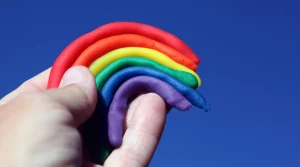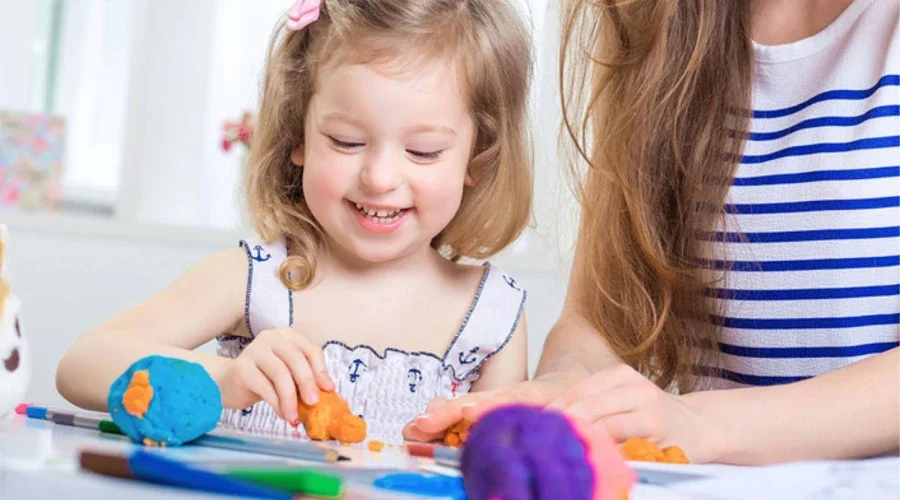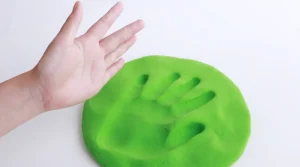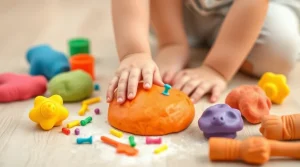
Can You Mix Playdough and Slime? Exploring the Science and Fun
Mixing playdough and slime: science, textures, and creative fun for kids. Learn what happens when these sensory materials come together!
#1 Toys Manufacturer in China. WhatsApp: +86 180-0088-4063. Email: [email protected]
#1 Toys Manufacturer in China. WhatsApp: +86 180-0088-4063. Email: [email protected]

Playdough might look simple, but behind the soft texture is a mix of everyday ingredients and fascinating science. It’s more than just a toy—it’s a working model of chemistry in action.
At its core, playdough is made from flour, salt, water, oil, and cream of tartar. Some recipes add coloring or scents, but the science lies in the basics.
Together, these ingredients form a soft, elastic material that’s easy to shape and squeeze. The balance of water and flour is key. Too much water makes it sticky. Too much flour makes it crumbly.
People often confuse playdough with modeling clay. But they are quite different in chemistry and use.
Playdough is water-based and dries out over time. It’s soft, non-toxic, and mostly made from food-safe items. It’s great for kids and sensory learning. But it isn’t permanent—leave it out too long, and it hardens.
Modeling clay, like polymer clay, is oil- or plastic-based. It doesn’t dry out in air. Some types must be baked to harden. These clays can last for years, but they’re not meant to be handled by small children without supervision.
You could say playdough is more alive—changing with time and touch—while modeling clay is built to last.
Interestingly, playdough wasn’t made for play at first. In the 1930s, it was a wallpaper cleaner. People used it to wipe coal dust off walls.
By the 1950s, teachers noticed kids liked shaping the cleaner in class. Soon, it was rebranded and sold as a toy. The science didn’t change—just the audience.
Today, playdough is in classrooms, kitchens, and therapy centers. But every time a child squishes it in their hand, they’re unknowingly experimenting with material science.
Playdough is fun to touch, but behind its squishy feel is a smart mix of chemistry. Its texture and shape-holding ability depend on how basic ingredients interact.
Each ingredient in playdough has a job.
These simple kitchen ingredients react to form a flexible, slightly grainy paste that dries slowly.
Flour is mostly starch, but it also contains protein—mainly gluten. When water is added, gluten forms elastic strands, like stretchy nets.
Starch, on the other hand, absorbs water and swells. It fills in the gaps between the gluten networks. Together, they form a structure that’s soft yet strong.
This mix of polymers (starch and protein chains) is why playdough bends, stretches, and even tears with a bit of force. It’s not just mush—it’s a real molecular network.
The dough feels soft because water and oil make it flexible. But it holds shape because of the gluten-starch structure.
Think of it like this: gluten is the net, starch is the stuffing, and water is the glue. Oil smooths the surface and slows down drying. That’s why your snowman or snail shape can sit for hours before getting too hard.
Even air exposure is part of the equation—it slowly evaporates moisture, causing the shape to firm up over time.
Playdough is a great way to explore how materials behave. It acts like a solid, flows like a liquid under pressure, and behaves like something in between.
Playdough is a colloid—a mix where small solid particles are spread throughout a liquid, but don’t settle out. It isn’t fully solid or liquid. It’s in-between.
This is why playdough bends and flows when squeezed, but stays in shape when left alone. It behaves like a non-Newtonian material, where its behavior depends on how much force you apply.
Viscosity is how thick or sticky something is. The more water you add, the lower the viscosity. But if it’s too wet, it turns into a sticky mess.
On the flip side, if it dries out too much, it becomes crumbly and stiff. The goal is balance. That’s why sealing playdough in a container matters—it keeps the moisture level just right.
Playdough changes with temperature. When it’s warm, it feels softer and easier to shape. That’s because heat weakens the bonds between molecules.
When cold, the dough stiffens and feels harder. The molecules slow down, making the dough resist movement. Extreme heat, like in an oven, can make it dry out too fast and crack.
This sensitivity to temperature is part of what makes playdough a great material to teach basic physical science.
Playdough feels soft at first, but over time, it dries and cracks. This isn’t just about forgetting to put the lid on. There’s science behind the loss of moisture and texture.
Playdough contains water, and like all moist materials, it loses water into the air through evaporation. As water molecules escape, the dough becomes drier and harder.
The process is slow at first but speeds up once the outer surface starts to stiffen. That’s why exposed playdough dries from the outside in.
Salt isn’t just for flavor—it helps preserve playdough. Salt draws moisture out of microbial cells through osmosis, preventing mold and bacterial growth.
It also slows evaporation slightly by binding with water molecules. That’s why most homemade and educational dough recipes include lots of salt.
Heat, wind, and low humidity all cause faster drying. Leaving playdough near a window, heater, or under a fan can make it unusable in just a few hours.
Also, thin shapes or small pieces dry much faster than thick ones because they have more surface area. Even handling it too much with warm hands can speed things up.
Playdough isn’t just fun—it stimulates the brain. Touch, color, scent, and movement all activate different areas of a child’s developing nervous system.
When kids press, roll, and shape playdough, they build fine motor skills. The resistance helps strengthen muscles and sharpen hand-eye coordination.
These activities also trigger the somatosensory cortex, the brain area that processes touch. It’s a low-risk, hands-on way for kids to learn through doing.
Bright colors help kids with pattern recognition. Some types of playdough also have scents, which can stimulate olfactory memory and mood.
The dough’s resistance—how hard or easy it is to squish—gives immediate feedback. This helps children adjust pressure and motion in real time.
Playdough helps teach measurement, volume, structure, and physics. Kids can build models, test strength, and explore balance and weight.
In STEAM lessons, it’s used to create simple circuits with conductive dough or to mimic geological layers. It’s science, tech, engineering, art, and math—all in one squishy lump.
Playing with dough isn’t random. Every poke, squeeze, and roll shows off basic physics. Kids may not know the terms, but their hands understand.
Kneading stretches and aligns the long starch molecules in flour. This makes the dough more elastic and smooth. It also spreads water and salt evenly.
At a molecular level, you’re breaking some bonds and forming new ones. That’s why the texture improves the more you handle it.
Newton’s laws of motion are at work when you press playdough. Push harder—it flattens more. Apply force quickly—it may crack. Slowly—and it squishes smoothly.
It’s a simple way to explore cause and effect, force, and mass, even without math or fancy equipment.
You can make bridges, towers, or press objects into the dough to see pressure patterns. Try stretching a piece slowly—see how it thins and finally breaks?
This hands-on material shows tension, compression, and shear force in ways books alone can’t teach. It’s physics made personal.
Most parents have opened a playdough container only to find fuzzy spots or a strange smell. Yes—playdough can grow mold. But not always, and not for the same reasons.
Homemade playdough, often made without preservatives, is more likely to grow mold, yeast, or bacteria over time. Store-bought dough usually contains agents like potassium sorbate or salt to slow growth.
Moisture, sugar, and flour are all things that microbes love. Once opened, any dough is exposed to airborne spores.
Microbes thrive in warm, moist, and nutrient-rich environments. If playdough is stored in a damp or unsealed container, it can become a mini greenhouse for growth.
Also, dirty hands introduce bacteria and oils. That’s why frequent use can speed up contamination—even if the dough looks fine.
Keep playdough in a sealed container, store it in a cool spot, and always wash hands before and after use. If the dough smells sour, feels slimy, or shows visible mold—discard it.
Regular inspection and proper hygiene go a long way in keeping dough safe and fun.
>> Crafting Fun: The Different Types of Playdough for Every Activity
Playdough isn’t just a toy. It can become a lab. Simple ingredients allow kids to explore chemistry right at the kitchen table—with colorful, bubbly results.
Mixing baking soda into playdough, then adding vinegar, creates a classic acid-base reaction. It fizzes as carbon dioxide gas forms and escapes.
This is a safe and fun way to introduce kids to chemical reactions, gas formation, and pH concepts. Just don’t eat the foam.
You can make color-changing dough by mixing in red cabbage juice. This natural pH indicator shifts color depending on acidity.
Add lemon juice or vinegar—watch it turn pink. Add baking soda—it may go greenish-blue. It’s simple chemistry in action, with clear visual results.
Some homemade doughs use salt to make them electrically conductive. You can insert batteries and LEDs to create working circuits.
This brings basic electronics into tactile play. Kids can light up shapes, test currents, and learn about conductors and insulators through squishy exploration.
Playdough encourages scientific thinking. It’s a perfect material for testing, exploring, and observing real-world principles without needing a lab.
When kids mix two colors or add too much flour, they see instant results. Soft, stiff, sticky—playdough changes quickly with inputs.
These experiences build a child’s sense of cause and effect. Change one variable, and you change the outcome.
Playdough shows reversible physical changes like stretching, tearing, or softening. It helps kids distinguish between chemical and physical reactions.
No special equipment is needed. Observation is enough. This builds attention to detail and early scientific thinking.
Playdough invites open-ended exploration. There are no “right” answers—only experiments. Kids can build, test, and adjust their ideas in real time.
This process mirrors real science: form a hypothesis, try it out, learn from the results.
Once dried out or contaminated, what should you do with old playdough? Disposal can teach kids about waste, decomposition, and eco-conscious living.
Most homemade playdoughs are biodegradable, since they’re made from flour, salt, oil, and water. Store-bought types may contain synthetics, which break down slower.
Disposal methods depend on ingredients. Read the label or recipe to know for sure.
If your playdough is natural, you can toss small bits into the compost bin, though large chunks take time to break down. For most doughs, wrapping and placing in household trash is best.
Avoid washing playdough down the sink—it can clog pipes and harm water systems.
Some recipes use food coloring with petroleum-based dyes or synthetic preservatives. For eco-friendlier playdough, avoid these.
Use natural colorants (like turmeric or beet powder), and avoid plastic glitter. This keeps both your crafts and the planet a little cleaner.
Playdough may seem simple, but it’s packed with science. From chemistry and physics to sensory learning, this squishy material is a hands-on way to explore big ideas—no lab coat needed.
Yes! Playdough is great for teaching science at home. Kids can learn about physical changes, pressure, and even basic electricity by building circuits with conductive dough. It encourages observation, prediction, and hands-on exploration—key elements of scientific thinking.
Stickiness usually means too much water or not enough salt. Dryness means water has evaporated. Both are physical changes that reflect playdough’s moisture balance. Adding small amounts of flour or water can help adjust the consistency depending on the condition.
Homemade playdough can be safe if made with food-grade ingredients and no harmful dyes or essential oils. However, supervision is key since most recipes still contain high salt, which can be dangerous if eaten in large amounts.
Absolutely. Playdough is a flexible medium for models, sculptures, and simple stop-motion animation. It helps kids visualize form and space and supports creativity in both science and art-based schoolwork.
Store-bought playdough can last several months when sealed. Homemade versions typically last 1–2 weeks. Humidity, dirty hands, and air exposure all reduce shelf life. If mold appears or it smells sour, it should be discarded.
More Related...

Mixing playdough and slime: science, textures, and creative fun for kids. Learn what happens when these sensory materials come together!

Maximize your playdough and air dry clay’s freshness with easy storage tips and tricks that keep them soft and ready to use.

Playdough is a good craft toy, especially suitable for children aged 3+ to develop hands-on skills. Now let’s make a cute caterpillar craft.

Playdough or traditional clay? Learn which one offers the best opportunities for creative play and developmental growth for your child!

Our team will answer your inquiries within 48 hours.
Copyright © 2025 GuangDong AKIA Technology Co,. Ltd. All Rights Reserved